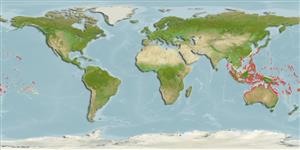>
Eupercaria/misc (Various families in series Eupercaria) >
Labridae (Wrasses) > Corinae
Etymology: Halichoeres: Greek, als, alis = salt + Greek, choiros = pig (Ref. 45335).
More on author: Valenciennes.
Environment: milieu / climate zone / depth range / distribution range
Sinh thái học
Biển Cùng sống ở rạn san hô; Mức độ sâu 0 - 5 m (Ref. 30874). Tropical; 32°N - 32°S, 91°E - 133°W
Indo-Pacific: Cocos Island in the eastern Indian Ocean to the Line and Tuamoto islands, north to southern Japan, south to New South Wales and Lord Howe Island. Replaced by Halichoeres nebulosus in the western Indian Ocean.
Bộ gần gũi / Khối lượng (Trọng lượng) / Age
Maturity: Lm ? range ? - ? cm
Max length : 12.5 cm SL con đực/không giới tính; (Ref. 9823)
Các tia vây lưng cứng (tổng cộng): 9; Các vây lưng mềm (tổng cộng): 11; Tia cứng vây hậu môn 3; Tia mềm vây hậu môn: 11. Females olivaceous on back, the scale edges dark brown, pale ventrally, with whitish blotches of unequal size and a large pink area posteriorly on the abdomen; a black spot on opercular flap, small one behind eye, one at front of dorsal fin and a large one rimmed in yellow or blue in middle of fin; no black spot at upper base of pectoral fins; males green with orange-red spots, some linked to form irregular markings, the white blotches and large pink area on abdomen lost, and the black spots lost or reduced. Males are distinguished by different cheek patterns. In this species, it has a near horizontal pink band below the eye (Ref. 48636).
Inhabits shallow reefs and rocky shores, usually in weedy areas exposed to surge (Ref. 9710, 48636). Feeds on benthic crustaceans, mollusks, polychaetes, forams, fishes, and fish eggs (Ref. 1602). One of several similar species that have near identical juvenile and female stages (Ref. 48636).
Life cycle and mating behavior
Chín muồi sinh dục | Sự tái sinh sản | Đẻ trứng | Các trứng | Sự sinh sản | Ấu trùng
Distinct pairing during breeding (Ref. 205).
Randall, J.E., G.R. Allen and R.C. Steene, 1990. Fishes of the Great Barrier Reef and Coral Sea. University of Hawaii Press, Honolulu, Hawaii. 506 p. (Ref. 2334)
IUCN Red List Status (Ref. 130435)
Threat to humans
Harmless
Human uses
Bể nuôi cá: Tính thương mại
Thêm thông tin
Các tài liệu tham khảoNuôi trồng thủy sảnTổng quan nuôi trồng thủy sảnCác giốngDi truyềnElectrophoresesDi sảnCác bệnhChế biếnNutrientsMass conversion
Các công cụ
Special reports
Download XML
Các nguồn internet
Estimates based on models
Preferred temperature (Ref.
123201): 24.7 - 29.1, mean 28.4 °C (based on 1912 cells).
Phylogenetic diversity index (Ref.
82804): PD
50 = 0.5000 [Uniqueness, from 0.5 = low to 2.0 = high].
Bayesian length-weight: a=0.00955 (0.00451 - 0.02020), b=3.09 (2.92 - 3.26), in cm total length, based on LWR estimates for this Genus-body shape (Ref.
93245).
Mức dinh dưỡng (Ref.
69278): 3.7 ±0.50 se; based on food items.
Thích nghi nhanh (Ref.
120179): Chiêù cao, thời gian nhân đôi của chủng quần tối thiểu là dưới 15 tháng (Preliminary K or Fecundity.).
Fishing Vulnerability (Ref.
59153): Low vulnerability (10 of 100).
Nutrients (Ref.
124155): Calcium = 104 [59, 191] mg/100g; Iron = 0.742 [0.405, 1.467] mg/100g; Protein = 18.6 [15.7, 20.8] %; Omega3 = 0.139 [0.080, 0.238] g/100g; Selenium = 14.9 [7.9, 30.9] μg/100g; VitaminA = 181 [50, 712] μg/100g; Zinc = 1.82 [1.18, 2.92] mg/100g (wet weight);
